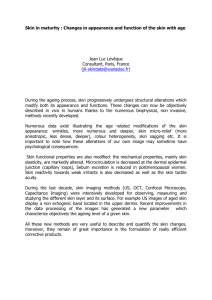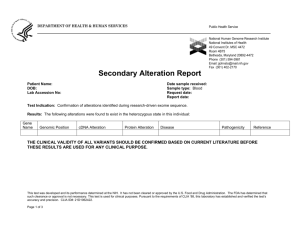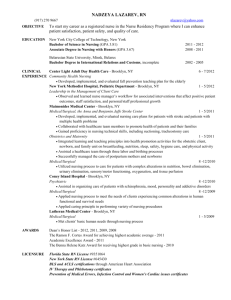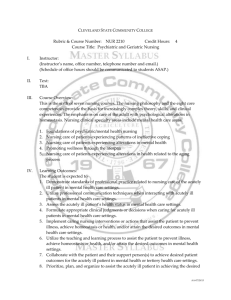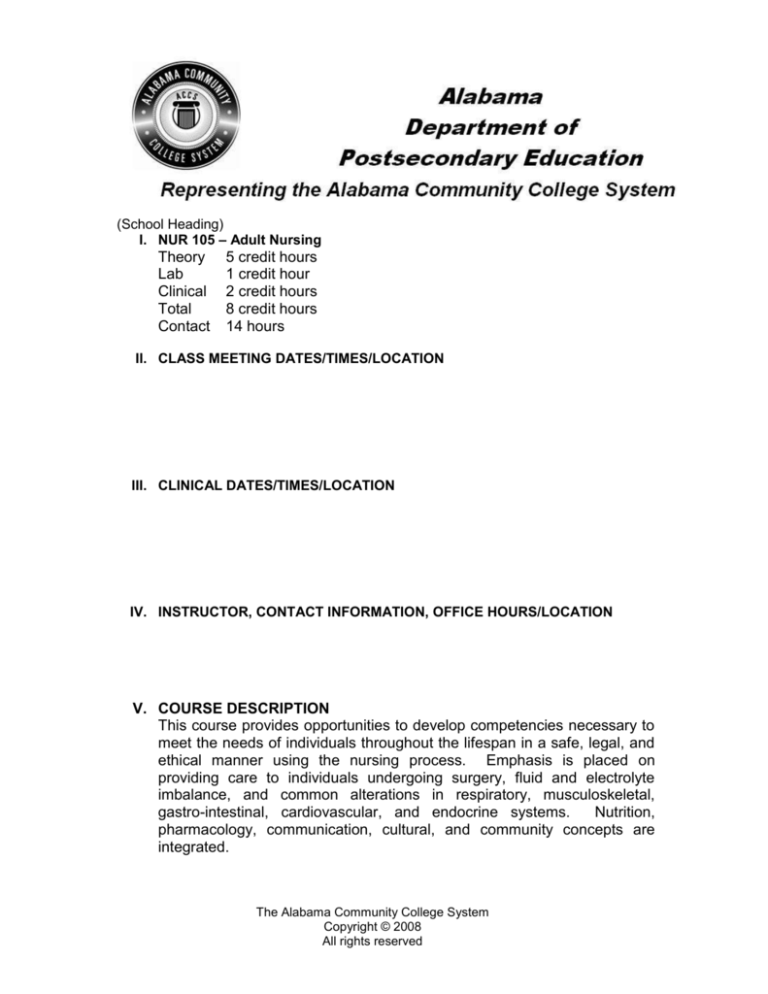
(School Heading)
I. NUR 105 – Adult Nursing
Theory
Lab
Clinical
Total
Contact
5 credit hours
1 credit hour
2 credit hours
8 credit hours
14 hours
II. CLASS MEETING DATES/TIMES/LOCATION
III. CLINICAL DATES/TIMES/LOCATION
IV. INSTRUCTOR, CONTACT INFORMATION, OFFICE HOURS/LOCATION
V. COURSE DESCRIPTION
This course provides opportunities to develop competencies necessary to
meet the needs of individuals throughout the lifespan in a safe, legal, and
ethical manner using the nursing process. Emphasis is placed on
providing care to individuals undergoing surgery, fluid and electrolyte
imbalance, and common alterations in respiratory, musculoskeletal,
gastro-intestinal, cardiovascular, and endocrine systems.
Nutrition,
pharmacology, communication, cultural, and community concepts are
integrated.
The Alabama Community College System
Copyright © 2008
All rights reserved
Adult Nursing
NUR 105
VI. PREREQUISITE(S)/COREQUISITE(S)
PREREQUISITE COURSES
NUR 102 – Fundamentals of Nursing
NUR 103 – Health Assessment
NUR 104 – Introduction to Pharmacology
BIO 201 – Human Anatomy and Physiology I or NUR 101 – Body
Structure and Function (if selected by PN students)
Math requirement
CO-REQUISITE COURSES
NUR 106 – Maternal and Child Nursing
ENG 101 – English Comp I
BIO 202 – Anatomy and Physiology II
VII. TEXTBOOK(S) AND OTHER LEARNING RESOURCES
ACCS Copyright © 2008
All rights reserved
2
Adult Nursing
NUR 105
VIII. COMPETENCIES AND OBJECTIVES
MODULE A – FLUID, ELECTROLYTE, AND ACID BASE BALANCE
A1.0 Promote fluid and electrolyte homeostasis.
A1.1 Assess a client to determine fluid and electrolyte
homeostasis.
A1.1.1 Define terms associated with fluid and electrolyte
homeostasis.
A1.1.2 Explain the physiology of fluids and electrolytes.
A1.1.3 Explain how the body’s regulators systemically maintain
homeostasis.
A1.1.4 Identify causes of fluid and electrolyte imbalance.
A1.1.5 Interpret clinical manifestations to determine types of
fluid and electrolyte imbalance.
A1.1.6 Identify treatment modalities for maintaining fluid and
electrolyte homeostasis.
A1.1.7 Evaluate outcomes of treatment modalities for
maintaining fluid and electrolyte homeostasis.
A1.2 Use the nursing process to promote fluid and electrolyte
homeostasis.
A2.0 Promote acid-base homeostasis.
A2.1 Assess a client to determine acid-base homeostasis.
A2.1.1 Define terms associated with acid-base homeostasis.
A2.1.2 Explain the physiology of acids and bases.
A2.1.3 Explain how the body’s regulators systemically maintain
homeostasis for acid-base.
A2.1.4 Identify causes of acid-base imbalance.
A2.1.5 Interpret clinical manifestations to determine types of
acid-base imbalance.
A2.1.6 Identify treatment modalities for maintaining acid-base
homeostasis.
A2.1.7 Evaluate outcomes of treatment modalities for
maintaining acid-base homeostasis.
A2.2 Use the nursing process to promote acid-base homeostasis.
ACCS Copyright © 2008
All rights reserved
3
Adult Nursing
NUR 105
MODULE B – Venipuncture and Intravenous (IV) Therapy
B1.0 Perform venipuncture and IV therapy.
B1.1 Perform venipuncture.
B1.1.1 Define terms associated with IV Therapy.
B1.1.2 Describe key points of the Nurse Practice Act concerning
intravenous therapy.
B1.1.3 Explain CDC guidelines and agency policies for
intravenous therapy.
B1.1.4 Explain selected concepts of ethics and patient’s rights
related to intravenous therapy.
B1.1.5 Differentiate between the registered and practical nurse’s
responsibilities for intravenous therapy.
B1.1.6 Explain the registered and practical nurse’s
responsibilities in administration of blood, blood products,
and volume expanders.
B1.1.7 Interpret doctor’s orders for intravenous therapy.
B1.1.8 Explain the anatomical and physiological considerations
associated with intravenous therapy.
B1.1.9 Explain rationale for the selection of intravenous
solutions.
B1.1.10 Describe the purpose of equipment and supplies for
intravenous therapy.
B1.1.11 Select appropriate equipment and supplies for specified
intravenous therapy.
B1.1.12 Describe the process of preparing a patient for
intravenous therapy.
B1.1.13 Describe the process of preparing the equipment for
performing intravenous therapy.
B1.1.14 Calculate IV flow rates.
B1.1.15 Describe the process of starting the intravenous therapy.
B1.2 Initiate intravenous therapy.
B1.2.1 Describe the process of managing intravenous therapy
including IV piggyback and saline flush.
B1.3 Maintain intravenous therapy.
B1.3.1 Identify expected outcomes of treatment modalities for IV
Therapy.
B1.3.2 Use critical thinking to prioritize management of care for
clients receiving selected IV Therapy.
B2.0 Obtain blood specimens.
B2.1 Collect blood specimens.
B2.1.1 Identify equipment and techniques for collecting blood
specimens.
B2.1.2 Select the appropriate color collection tube for an
ordered diagnostic test based on organizational protocol.
B2.1.3 Describe the process of preparing a patient for collecting
blood specimens.
B2.1.4 Explain the process for obtaining blood specimens.
B2.1.5 Explain CDC guidelines and/or agency policies for
handling blood specimens.
B2.1.6 Explain the procedures for handling and disposing of
specimen gathering materials.
ACCS Copyright © 2008
All rights reserved
4
Adult Nursing
NUR 105
Module B (Continued)
B2.2 Handle blood specimens according to policy and protocol.
B2.2.1 Explain CDC guidelines and/or agency policies for
handling blood specimens.
B2.2.2 Explain the procedures for handling and disposing of
specimen gathering materials.
MODULE C – PERIOPERATIVE CARE
C1.0 Provide perioperative care.
C1.1 Given clinical situations use the nursing process to provide
perioperative care.
C1.1.1 Define terms associated with perioperative care.
C1.1.2 Explain the nurse’s role within perioperative settings.
C1.1.3 Explain the elements of informed consent.
C1.1.4 Explain nursing process for perioperative care.
C1.1.5 Explain preoperative care.
C1.1.6 Explain intraoperative care.
C1.1.7 Explain postoperative care.
C1.1.8 Describe techniques for acute pain management.
C1.1.9 Use critical thinking to prioritize management of care.
C1.2 Develop a nursing care plan to provide perioperative care.
C1.3 Evaluate the effectiveness of perioperative care.
MODULE D – RESPIRATORY SYSTEM ALTERATIONS
D1.0 Care for clients with respiratory system alterations.
D1.1 Assess a client for selected respiratory system alterations.
D1.1.1 Explain the anatomy and physiology of respiratory
system.
D1.1.2 Define terms associated with the respiratory system.
D1.1.3 Describe diagnostic tests for respiratory system
alterations.
D1.1.4 Describe upper respiratory system alterations.
D1.1.5 Describe lower respiratory system alterations.
D1.1.6 Describe respiratory failure for adult clients.
D1.1.7 Interpret clinical manifestations to determine necessary
care for respiratory system alterations.
D1.2 Develop a nursing care plan to provide care for a client with
selected respiratory system alterations.
D1.2.1 Describe the process of tracheotomy care, suctioning,
and chest physiotherapy.
D1.2.2 Describe the pharmacological agents for respiratory
system alterations.
D1.2.3 Describe nutritional considerations for treating respiratory
system alterations.
D1.3 Implement a nursing care plan to provide care for a client
with selected respiratory system alterations.
D1.3.1 Describe the process for implementing a nursing care
plan to treat respiratory system alterations.
ACCS Copyright © 2008
All rights reserved
5
Adult Nursing
NUR 105
Module D (Continued)
D1.4
Evaluate the effectiveness of interventions for a client with
respiratory system alterations.
D1.4.1 Identify expected outcomes of treatment modalities for
respiratory system alterations.
D1.4.2 Use critical thinking to prioritize management of care.
MODULE E – CARDIOVASCULAR SYSTEM ALTERATIONS
E1.0 Care for clients with selected cardiovascular system alterations.
E1.1 Assess a client to determine selected cardiovascular system
alterations.
E1.1.1 Explain the anatomy and physiology of cardiovascular
system.
E1.1.2 Define terms associated with the cardiovascular system
E1.1.3 Describe diagnostic tests for selected cardiovascular
system alterations and complications.
E1.1.4 Describe selected cardiovascular system alterations and
complications.
E1.1.5 Interpret clinical manifestations to determine selected
cardiovascular system alterations and complications.
E1.2 Develop a nursing care plan to treat selected cardiovascular
system alterations.
E1.2.1 Describe the pharmacological agents for selected
cardiovascular system alterations and complications.
E1.2.2 Describe nutritional considerations for treating selected
cardiovascular system alterations and complications.
E1.2.3 Describe the nursing process for providing care for
selected cardiovascular system alterations and
complications.
E1.3 Implement a nursing care plan to treat selected
cardiovascular system alterations.
E1.3.1 Describe the process for implementing a nursing care
plan to treat selected cardiovascular system alterations.
E1.4 Evaluate the effective of interventions to treat selected
cardiovascular system alterations.
E1.4.1 Identify expected outcomes of treatment modalities of
selected cardiovascular system alterations and
complications.
E1.4.2 Use critical thinking to prioritize management of care.
ACCS Copyright © 2008
All rights reserved
6
Adult Nursing
NUR 105
MODULE F – ENDROCRINE SYSTEM ALTERATIONS
F1.0 Care for clients with selected endocrine system alterations.
F1.1 Assess a client to determine selected endocrine system
alterations.
F1.1.1 Explain the anatomy and physiology of endocrine
system.
F1.1.2 Define terms associated with the endocrine system
F1.1.3 Describe diagnostic tests for selected endocrine system
alterations and complications.
F1.1.4 Describe selected endocrine system alterations and
complications.
F1.1.5 Interpret clinical manifestations to determine selected
endocrine system alterations and complications.
F1.2 Develop a nursing care plan to treat selected endocrine system
alterations.
F1.2.1 Describe the pharmacological agents for selected
endocrine system alterations and complications.
F1.2.2 Describe nutritional considerations for treating selected
endocrine system alterations and complications.
F1.2.3 Describe the nursing process for providing care for
selected endocrine system alterations and complications.
F1.3 Implement a nursing care plan to treat selected endocrine
system alterations.
F1.3.1 Describe the process for implementing a nursing care
plan to treat selected endocrine system alterations.
F1.4 Evaluate the effective of interventions to treat selected
endocrine system alterations.
F1.4.1 Identify expected outcomes of treatment modalities of
selected endocrine system alterations and complications.
F1.4.2 Use critical thinking to prioritize management of care.
ACCS Copyright © 2008
All rights reserved
7
Adult Nursing
NUR 105
MODULE G – GASTROINTESTINAL SYSTEM ALTERATIONS
G1.0 Care for clients with selected gastrointestinal system alterations.
G1.1 Assess a client to determine selected gastrointestinal system
alterations.
G1.1.1 Explain the anatomy and physiology of gastrointestinal
system.
G1.1.2 Define terms associated with the gastrointestinal system
G1.1.3 Describe diagnostic tests for selected gastrointestinal
system alterations and complications.
G1.1.4 Describe selected gastrointestinal system alterations and
complications.
G1.1.5 Interpret clinical manifestations to determine selected
gastrointestinal system alterations and complications.
G1.2 Develop a nursing care plan to treat selected gastrointestinal
system alterations.
G1.2.1 Describe the pharmacological agents for selected
gastrointestinal system alterations and complications.
G1.2.2 Describe nutritional considerations for treating selected
gastrointestinal system alterations and complications.
G1.2.3 Describe the nursing process for providing care for
selected gastrointestinal system alterations,
complications, and surgical procedures.
G1.3 Implement a nursing care plan to treat selected
gastrointestinal system alterations.
G1.3.1 Describe the process for implementing a nursing care
plan to treat selected gastrointestinal system alterations.
G1.4 Evaluate the effectiveness of interventions to treat selected
gastrointestinal system alterations.
G1.4.1 Identify expected outcomes of treatment modalities of
selected gastrointestinal system alterations and
complications.
G1.4.2 Use critical thinking to prioritize management of care.
G1.5 Manage gastric decompression.
G1.5.1 Explain the process of managing gastric decompression.
G1.6 Reinsert a selected gastrostomy tube.
G1.6.1 Describe the process of reinserting a selected
gastrostomy tube.
ACCS Copyright © 2008
All rights reserved
8
Adult Nursing
NUR 105
MODULE H – MUSCULOSKELETAL SYSTEM ALTERATIONS
H1.0 Care for clients with musculoskeletal system trauma and alterations.
H1.1 Assess a client to determine musculoskeletal system trauma
and alterations.
H1.1.1 Explain the anatomy and physiology of musculoskeletal
system.
H1.1.1 Define terms associated with the musculoskeletal system
H1.1.2 Describe diagnostic tests for musculoskeletal system
trauma and alterations.
H1.1.3 Describe selected musculoskeletal system trauma and
alterations.
H1.1.4 Interpret clinical manifestations to determine
musculoskeletal system trauma and alterations.
H1.2 Develop a nursing care plan to treat musculoskeletal system
trauma and alterations.
H1.2.1 Describe the pharmacological agents for musculoskeletal
system trauma and alterations.
H1.2.2 Describe nutritional considerations for treating
musculoskeletal system trauma and alterations.
H1.2.3 Describe the nursing process for providing care for
musculoskeletal system alterations, complications, and
surgical procedures.
H1.3 Implement a nursing care plan to treat musculoskeletal
system trauma and alterations.
H1.3.1 Describe the process for implementing a nursing care
plan to treat musculoskeletal system trauma and
alterations.
H1.3.2 Explain the nursing process for assisting clients with cast
care and complications.
H1.3.3 Identify techniques for various crutch-walking methods.
H1.3.4 Identify techniques for various traction methods.
H1.4 Evaluate the effectiveness of interventions to treat
musculoskeletal system trauma and alterations.
H1.4.1 Identify expected outcomes of treatment modalities of
musculoskeletal system trauma and alterations.
H1.4.2 Describe techniques for management of chronic pain.
H1.4.3 Use critical thinking to prioritize management of care.
ACCS Copyright © 2008
All rights reserved
9
Adult Nursing
NUR 105
IX. EVALUATION AND ASSESSMENT
X. ATTENDANCE
a. Students are expected to attend all classes for which they are registered.
Students who are unable to attend class regularly, regardless of the
reason or circumstance, should withdraw from that class before poor
attendance interferes with the student’s ability to achieve the objectives
required in the course. Withdrawal from class can affect eligibility for
federal financial aid. Withdrawal from class can prohibit progression in
nursing and allied health programs.
b. Students are expected to attend all clinical rotations required for each
course. Only excused absences will be considered for make up.
However, due to limited clinical space and time, clinical make up days
cannot be guaranteed. Failure to complete clinical rotations will prohibit
progression in nursing and allied health programs.
XI. STATEMENT ON DISCRIMINATION/HARASSMENT
The College and the Alabama Board of Education are committed to providing
both employment and educational environments free of harassment or
discrimination related to an individual’s race, color, gender, religion, national
origin, age, or disability. Such harassment is a violation of State Board of
Education policy. Any practice or behavior that constitutes harassment is a
violation of State Board of Education policy. Any practice or behavior that
constitutes harassment or discrimination will not be tolerated.
XII. AMERICANS WITH DISABILITIES
The Rehabilitation Act of 1973 (Section 504) and the American with
Disabilities Act of 1990 state that qualified students with disabilities who meet
the essential functions and academic requirements are entitled to reasonable
accommodations. It is the student’s responsibility to provide appropriate
disability documentation to the College.
ACCS Copyright © 2008
All rights reserved
10
Adult Nursing
NUR 105
XIII. COURSE CALENDAR
ACCS Copyright © 2008
All rights reserved
11
Adult Nursing
NUR 105
XIV. STUDENT ACKNOWLEDGEMENT FORM
ACCS Copyright © 2008
All rights reserved
12

